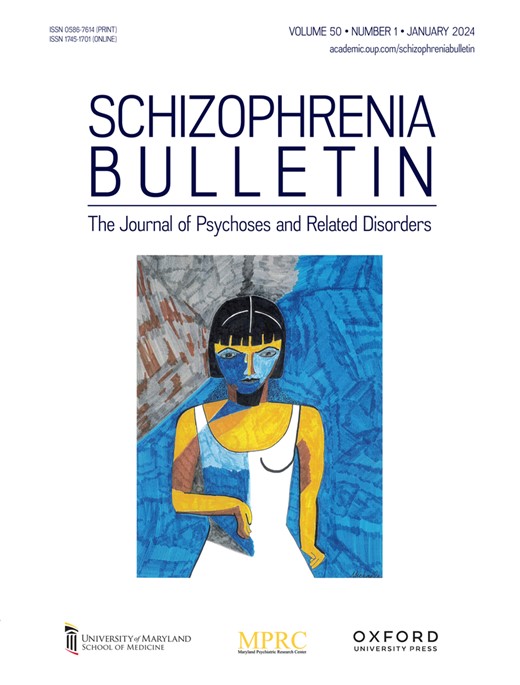”Short” Versus “Long” Duration of Untreated Psychosis in People with First-Episode Psychosis: A Systematic Review and Meta-Analysis of Baseline Status and Follow-Up Outcomes
IF 4.8
1区 医学
Q1 PSYCHIATRY
引用次数: 0
Abstract
Background and Hypothesis Duration of untreated psychosis (DUP) has been linked to worse mental health outcomes in psychotic disorders. We meta-analytically studied the relationship between “long” vs. “short” DUP and mental health outcomes. Study Design This PRISMA/MOOSE-compliant meta-analysis searched for nonoverlapping individual studies from database inception until November 01, 2023, reporting data from author-defined “short”/”long” DUP (according to author’s definition) in patients with first-episode psychosis (FEP). We compared differences between “short”/”long” DUP groups at baseline and/or follow-up in continuous and binary outcomes. We conducted random-effects meta-analyses, stratified analyses, heterogeneity analyses, meta-regression analyses, and quality assessment (PROSPERO: CRD42023479321). Study Results From 16,055 citations, 34 studies were included (n = 6,425, age = 27.5 ± 7.1 years, males = 60.4%, white = 70.2%, DUP: mean = 60.8 ± 43.8 weeks, median = 52.5, interquartile range = 31.3, 68.0 weeks, follow-up = 19.2 ± 35.0 months). The definition of “short”/”long” varies significantly between the studies. Compared to “short” DUP (mean = 10.2 ± 11.2 weeks), “long” DUP (mean = 58.8 ± 76.4 weeks) was associated with higher baseline Positive and Negative Syndrome Scale (PANSS) negative (k = 14, ES = 0.45, 95%CI = 0.16, 0.74) and Scale for the Assessment of Negative Symptoms (k = 7, ES = 0.29, 95%CI = 0.11, 0.47) scores, lower remission (k = 7, OR = 0.40, 95%CI = 0.24, 0.67) and more suicide attempts (k = 4, OR = 2.01, 95%CI = 1.36, 2.96). At follow-up, compared to “short” DUP, “long” DUP was associated with lower Global Assessment of Functioning (k = 4, ES = −0.63, 95%CI = −0.83, −0.43) and higher PANSS negative subscale scores (k = 5, ES = 0.66, 95%CI = 0.05, 1.27). Conclusions In FEP, longer DUP is related to greater baseline negative symptoms, less remission, and more suicide attempts, as well as greater postbaseline negative symptom severity and functional disability. To what degree longer DUP contributes to poorer outcomes or whether DUP only correlates with these outcomes requires further study. A greater consensus on the definition of long DUP is needed to make comparisons between studies more feasible.首发精神病患者未治疗精神病持续时间的 "短 "与 "长":基线状态和随访结果的系统回顾和元分析
背景与假设 精神病未经治疗的持续时间(DUP)与精神病患者较差的心理健康结果有关。我们对 "长 "与 "短 "DUP与心理健康结果之间的关系进行了荟萃分析研究。研究设计 本项符合PRISMA/MOOSE标准的荟萃分析检索了从数据库建立到2023年11月1日的非重叠个体研究,这些研究报告了作者定义的首发精神病患者(FEP)中 "短"/"长 "DUP(根据作者定义)的数据。我们比较了 "短"/"长 "DUP组在基线和/或随访中连续和二元结果的差异。我们进行了随机效应荟萃分析、分层分析、异质性分析、荟萃回归分析和质量评估(PROSPERO:CRD42023479321)。研究结果 从 16,055 次引用中,纳入了 34 项研究(n = 6,425 人,年龄 = 27.5 ± 7.1 岁,男性 = 60.4%,白人 = 70.2%,DUP:平均 = 60.8 ± 43.8 周,中位数 = 52.5,四分位数间范围 = 31.3 - 68.0 周,随访 = 19.2 ± 35.0 个月)。不同研究对 "短"/"长 "的定义差异很大。与 "短 "DUP(平均 = 10.2 ± 11.2 周)相比,"长 "DUP(平均 = 58.8 ± 76.4 周)与较高的基线阳性和阴性综合量表(PANSS)阴性(k = 14,ES = 0.45,95%CI = 0.16,0.74)和阴性症状评估量表(k = 7,ES = 0.29,95%CI = 0.11,0.47)评分,较低的缓解率(k = 7,OR = 0.40,95%CI = 0.24,0.67)和更多的自杀企图(k = 4,OR = 2.01,95%CI = 1.36,2.96)。随访时,与 "短 "DUP相比,"长 "DUP与较低的功能全面评估(k = 4,ES = -0.63,95%CI = -0.83,-0.43)和较高的PANSS阴性子量表评分(k = 5,ES = 0.66,95%CI = 0.05,1.27)相关。结论 在 FEP 中,较长的 DUP 与较多的基线阴性症状、较少的缓解和较多的自杀企图以及较多的基线后阴性症状严重程度和功能残疾有关。较长的DUP在多大程度上会导致较差的结果,或者DUP是否只与这些结果相关,还需要进一步研究。我们需要对长DUP的定义达成更多共识,以便对不同研究进行更可行的比较。
本文章由计算机程序翻译,如有差异,请以英文原文为准。
求助全文
约1分钟内获得全文
求助全文
来源期刊

Schizophrenia Bulletin
医学-精神病学
CiteScore
11.40
自引率
6.10%
发文量
163
审稿时长
4-8 weeks
期刊介绍:
Schizophrenia Bulletin seeks to review recent developments and empirically based hypotheses regarding the etiology and treatment of schizophrenia. We view the field as broad and deep, and will publish new knowledge ranging from the molecular basis to social and cultural factors. We will give new emphasis to translational reports which simultaneously highlight basic neurobiological mechanisms and clinical manifestations. Some of the Bulletin content is invited as special features or manuscripts organized as a theme by special guest editors. Most pages of the Bulletin are devoted to unsolicited manuscripts of high quality that report original data or where we can provide a special venue for a major study or workshop report. Supplement issues are sometimes provided for manuscripts reporting from a recent conference.
 求助内容:
求助内容: 应助结果提醒方式:
应助结果提醒方式:


